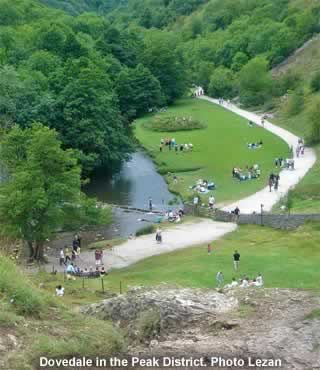The Peak District |
|
 |
|||
A place of incredible natural beauty and Britain's first national park |
Listen to this article |
In 1951, after being recognised as a place of incredible natural beauty, the Peak District became Britain's first national park. This means strict control of urban development and pollution, in order to ensure that the area can be enjoyed by generation after generation, for years to come. |
The district takes up 214 square miles in the midlands of England, mostly occupying northern Derbyshire, but sprawling into other counties as well. It is well-used by the British population, drawing in around 22 million visitors a year - making it one of the most popular national parks on the globe. |
The Peak District has been seen as an area of resource for centuries. The Romans used to mine various metals from its mineral-rich earth, and archaeologists have even found evidence of settlers here from the Bronze Age, many hundreds of years before Christ. Over the years, it has also been the site of textile mills, quarries, and farms. |
Tourism to the area isn't a new thing either - a book on the subject was published as early as the 17th century, although it certainly wasn't as popular a place as it is now. One notable critic described it as a "howling wilderness", and nicknamed one of the famous caverns the "Devil's arse"! Despite this, tourism has only increased since that time. |
The Peak District is made up of two distinct areas. The first, known as the "Dark Peak", is the higher, more northern section, covered in hills and wild, empty moor land. The southern section is called "White Peak", which contains more greenery, caves, and valleys. This is where most of the district's 38,000 residents make their homes. The population is generally centred in charming small towns like Bakewell, popular among tourists for their pretty townhouses and local markets. |
From there, visitors to the national park can indulge in a never-ending variety of activities. Hiking is of course, a great way to see the surrounding landscape, but there's much more to do, ranging all the way from casual cycling, to more extreme pursuits such as rock climbing and hang gliding. Watersports have also become popular at several of the larger reservoirs, drawing in sailors, canoeists, and fishermen. |
In the last few centuries, the Peak District has also been the setting for many works of fiction, including several scenes in Pride & Prejudice. William Wordsworth composed poetry here, and even Sherlock Holmes has investigated in the area. More recently, the district has been popular as a setting for film and TV. Parts of the classic war film "The Dam Busters" was shot here, flying over the same Derwent Dam used in 1943 for the testing of Barnes Wallace's famous bouncing bomb. The Peak district was also the location for several period dramas such as Jane Eyre and Pride and Prejudice. |
All in all, the Peak District has remained one of the most picturesque parts of the country for hundreds and hundreds of years. And with its protected National Park status, this should continue for hundreds more. |
|
Pocket Britain is optimised for use on a smartphone or tablet with internet access. All content is subject to copyright. All reasonable methods have been used to ensure information supplied is accurate at the time of publication. However, it is advisable to check information before relying on it. Privacy Policy |